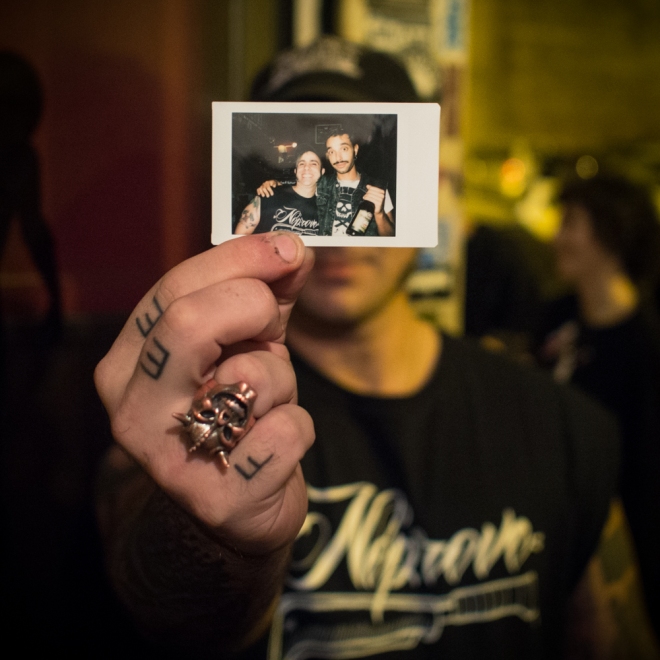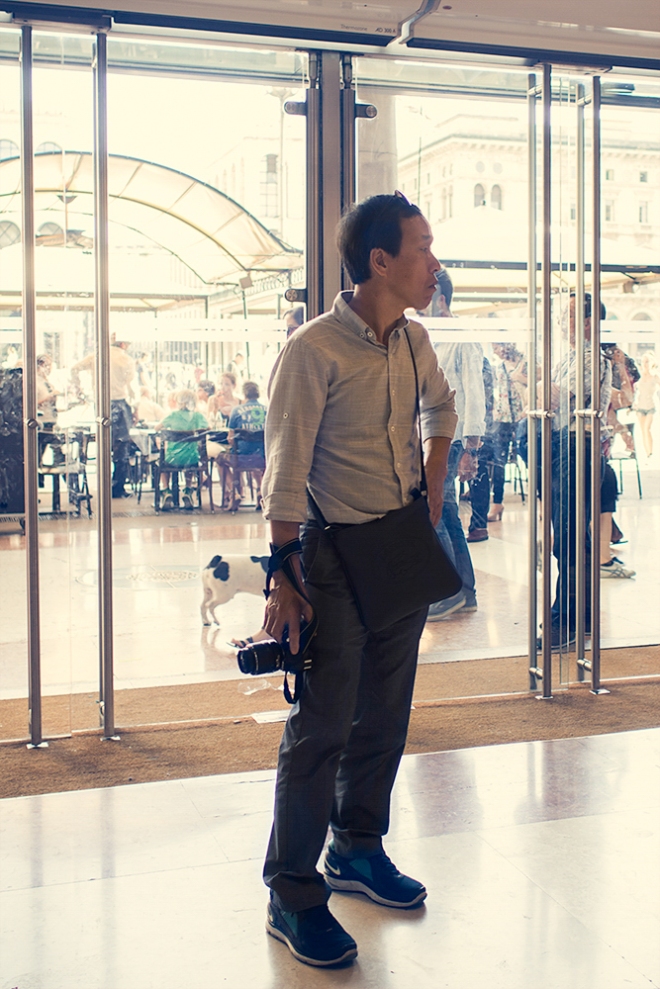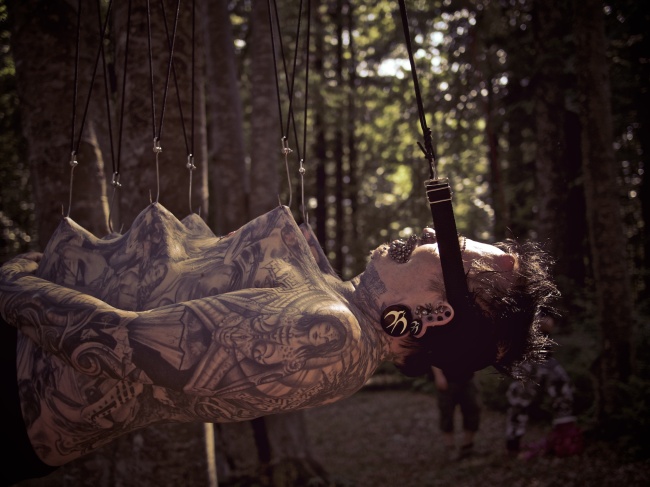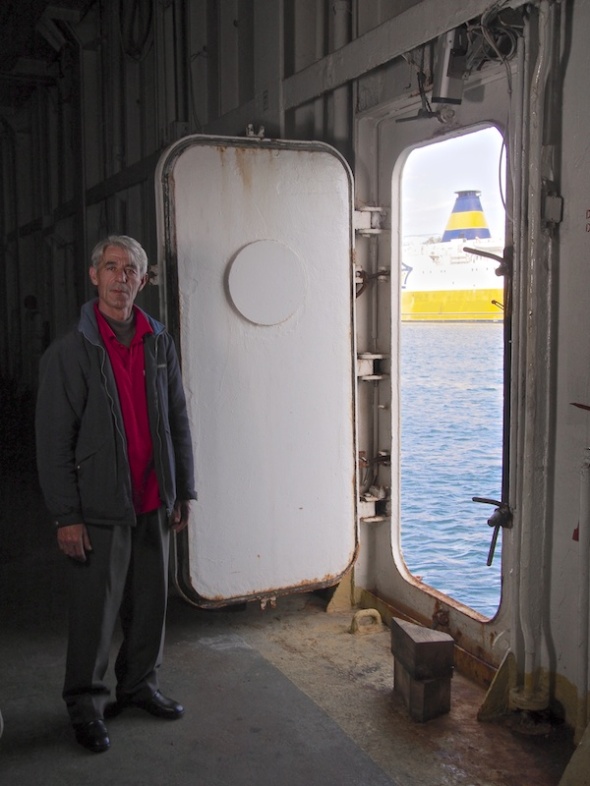I went to a punkrock record release party in Rome, last weekend. Shot some pics with the Fujifilm Instax Mini90 and had a lot of fun.
camera
A man and his camera
Professional reportage with Olympus OM-D, my transition from reflex to MFT cameras
I’ve always been a Canon fanboy, but in the last year I only touched my 7D and 5D a couple times.
I will hereby try to explain why I’d never leave my Olympus OM-D EM-5 again.
Since 2009 I’ve been dedicating myself exclusively to reportage photography. I spent the first three years on Suspension of Disbelief, my reportage about rituals of body suspension, and then I worked on Ionian Spirit, my latest work about a ship held hostage by its very crew.
I started Suspension of Disbelief using my Canon 5D Mk1 and subsequently I added a Canon 7D to the lot, in order to enjoy the higher FPS that were so badly needed during very dynamic suspensions I had the chance to witness around Europe. Everything was ok, I only had a couple things to complain about. First of all, two reflex cameras and a whole lot of lenses (namely my Canon 24mm L F1.4, 50mm F1.4, 100mm L IS F2.8, Sigma 12-24 F4.5 – 5.6 and, from time to time, the 70-200 L IS F2.8) were heavy. I suppose nobody ever died from bringing all that stuff on his back, and of course neither did I, but around 2010 I had already started leaving a lot of those things at home. By June 2011, all I was bringing along was the 7D and the 24mm in a Maxpedition Proteus Versipack waistpack strapped across my chest. Needless to say, my freedom of movement improved a lot.
The second thing that was annoying me was the fact that, around 2011, in the suspension community people started to acknowledge me and to be aware of my long term photographic project and so on. This was all good, of course: I didn’t want to hide myself in any way, but I didn’t like the fact that their reaction to my physical presence was changing. They were very aware that a big, professional reflex camera meant the possibility of being portrayed in a book, so they started to act a little different than before in front of me, being a little less natural. That was a big problem.
So I started thinking about a possible solution. I spent a whole year studying all the small, less-than-professional looking cameras on the market and then, around February 2012, the news about the forthcoming Olympus OM-D E-M5 hit me like a brick.
The silver version looked like everything I ever wanted: it was small, vintage looking (and therefore easily mistaken for an old, non professional camera), light, fast and its image quality was nothing short than awesome.
In May 2012 I succeeded in the not-exactly-easy task of finding a silver OM-D and in less then a month I left for the last stop of my reportage on body suspension, in the woods of Croatia. All I had in my waistpack was the Olympus OM-D E-M5, the Panasonic 20mm F1.7, the battery charger and a couple Sandisk Secure Digital memories.
From that day on I only used my Canon reflex cameras a couple times and basically I spent all my time shooting with the OM-D. In the final version of the book, pictures come from Canon 5D, 7D and the Olympus OM-D E-M5 and there’s absolutely no way to tell one from the other. Image quality has never been a concern and many times the OM-D outperformed the 7D in terms of noise. Using the AF straight from the display felt a little unprofessional at first, but allowed me to take very interesting pics from very interesting points of view. And to do that very, very quickly.
Of course, people changed their attitude towards me. Many people actually stopped noticing me (and changing their facial expression due to that), but the funniest part is that other photographers, often hired by the hosts of the events, kept asking me if that was my only camera and if I was really making a professional reportage with such non-professional equipment.
When I felt that the project was ready, I stopped running around Europe and started working on the book. I took care of the final stage (the actual publishing of the ebook) far from home, in southern Italy. While I was there I stumbled on this incredible story about the crew of a Greek ferry that decided to hold the ship hostage in order to force the company to pay their wages.
The story was too big not to cover it, so I took all the equipment I had with me at the moment and jumped aboard the captured ship. Needless to say, I only had my Olympus OM-D E-M5, my Panasonic 20mm F1.7 and a Canon Speedlite 580. Of course, I already knew that all those things were more than good enough to take excellent pictures, so I decided to take the stress test on my equipment a little further: I took all the pictures in JPEG format, insted of the more forgiving RAW.
After the first few days shooting inside the non-powered ship, with the weirdest light conditions ever, I realized that I would have never stepped away from the OM-D again. Every single picture was good straight out of the camera. And, I suppose, it couldn’t be in any different way, because JPEGs have a very small margin when it comes to postproduction, especially if, like me, you don’t make use of Photoshop.
If in 2009 you would have asked me if a MFT camera was good enough to be employed as the sole mean to make a professional reportage, I would have laughed at you, no doubt about it. But now I’m pretty sure that it’s the other way around, I feel that now it’s the time to question ourselves if reflex cameras are the only possible tool for a photographer. And my answer is, of course, a huge no.
(Both reportages are currently available for purchase on Lulu.com both in English and Italian)



